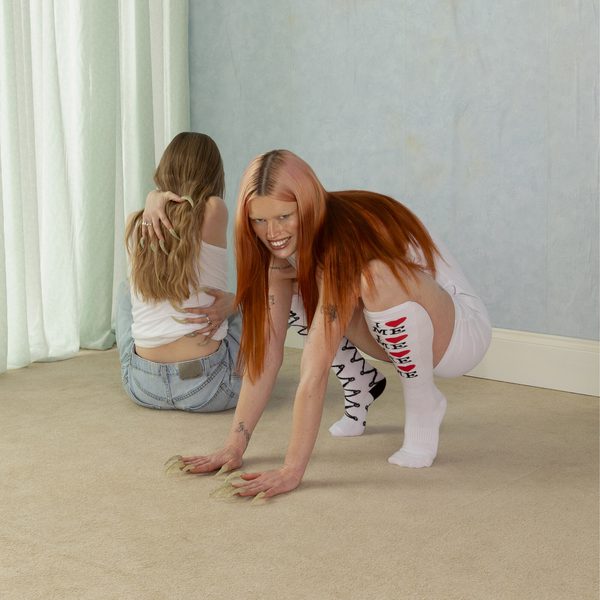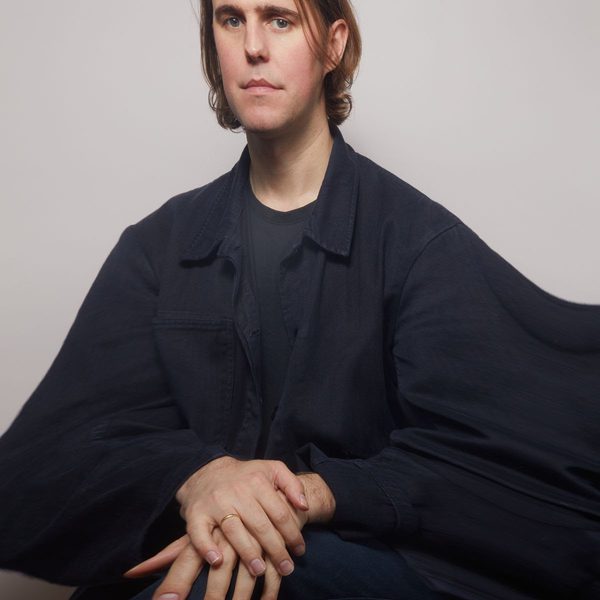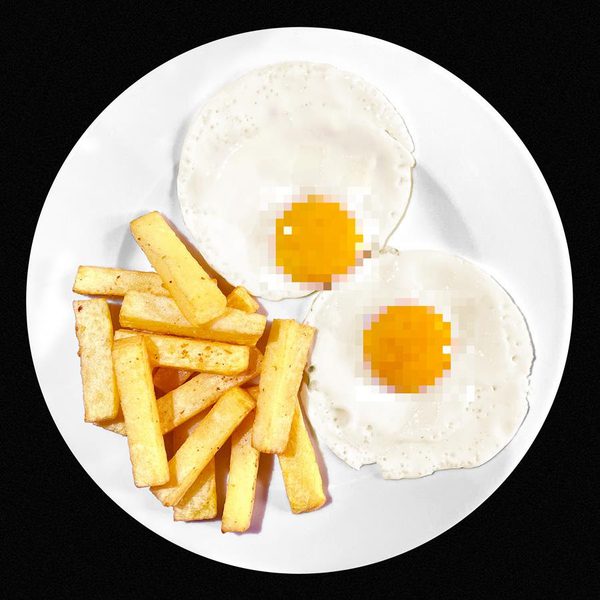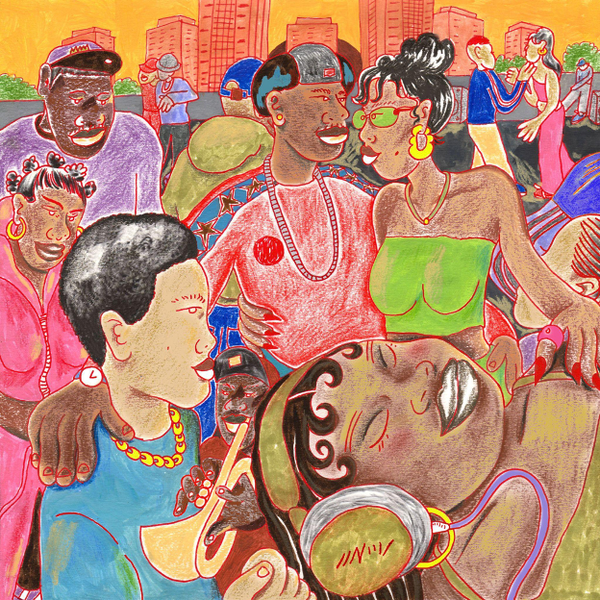Wild Combination: A Portrait of Arthur Russell
There is a hole at the heart of Matt Wolf’s gentle, affectionate, exhaustively researched biography of Arthur Russell, and that is its subject. It is a collection of extraordinary stories – of unconditional familial devotion; of love at first sight that outlasted death; of the 1970s and 1980s New York underground, where disco, pop and the avant-garde collided with explosive force. Yet at the end of the film, which lasts only an hour, it is impossible not to feel that Arthur Russell, the shy, obscure sun around which all of these worlds once aligned, remains as mysterious and unknowable as ever.
Russell was born Charlie Jr in Oskaloosa, Iowa, the sort of flat, endless prarie that anyone but its citizens would know only as a flyover state. In the film, a school portrait shows a supremely serious, button-nosed teenager in a black polo neck. He chose to play cello in the school band, because his mother also played it. He also smoked a little and read a lot – according to mum, “things that he really wasn’t emotionally old enough to handle. Like Timothy Leary.” “The rascal,” adds dad. One day, Charlie Sr found “paraphernalia” in Arthur’s bedroom – “marijuana, I think”. They rowed and Arthur – only his parents still called him Charlie – ran away to San Francisco. It was 1967.
Allen Ginsberg met Russell there a few years later, “in 1970 or so, ’71,” Ginsberg recalls. ” was wearing a strange, composite Buddhist uniform – semi-military, semi-Mongolian.” Though he is speaking at Russell’s funeral, over 20 years after that first meeting, Ginsberg still sounds bemused – the confusion of a radical out-radicalised, or an eccentric out-eccentrified. Russell entranced Ginsberg, taught him music theory, collaborated with him on musical and spoken-word pieces and, a few years later, moved on to New York.
The city was good to Russell. He gigged – Ginsberg, who had also moved to New York, praised his performances as “like William Carlos Williams, only he sings” – and became musical director of the Kitchen in Greenwich Village, a legendary avant-garde arts space where he worked with Philip Glass (” was one of the more… eccentric of our community”). He also brought the Modern Lovers, who he admired greatly, to play there. Ernie Brooks remembers Russell travelling to meet him at home in Cambridge, Massachusetts, early in 1974. Brooks, who formed the Flying Hearts with Russell soon after the Modern Lovers’ original lineup dissolved, remained a close friend for the rest of Russell’s life. “He was very awkward in a certain way, and very shy,” he says of Russell, “but at the same time he was very insistent. He thought that I had some rock secrets, or something, that he didn’t have. Arthur was like that. He really would go find what he thought he needed to complete his music.” In Cambridge, Russell was filmed playing and singing for Brooks in a tiny white room. He is on acoustic guitar, the tail of a cello just visible by his feet. In the blurry black-and-white footage, he looks like a young, swarthy Brad Pitt in a puffa jacket, jeans and shoulder-length hair. His singing is weird and captivating; at his most extreme, he sounds like a deaf person trying to enunciate the shapes of words with no understanding of their usual structure or cadence. His voice is simultaneously hollow and full, raspy and clear, and seems to resonate with the same harmonic overtones as the strings under his fingers. It is an extraordinary, intimate scene. It is also some of the only good-quality footage of Russell singing in the whole of the film.
Quiet and enigmatic, Russell caught the eye of Tom Lee as they passed each other periodically in the streets of the Village. As he remembers seeing Russell out and about – by the Tisch building, on 2nd Avenue, remembering locations with a New Yorker’s navigational precision – Lee grins with infectious delight. “The time when I finally met him, I was coming home from Danceteria. It was 2 o’clock in the morning and there he was, in the Gem Spa, buying an ice cream. And I just thought, I have to talk to this guy. I don’t know if he’s going to beat me up, or what’s going to happen. This idea that I was gay and he was gay never… at that time, didn’t cross my mind.” “From the beginning, they were so naturally a couple that you couldn’t imagine them being apart,” says Steven Hall, an old friend of Russell’s and Ginsberg’s. “Arthur couldn’t believe he was so lucky to have Tom. Tom made the whole thing possible.”
Danceteria, The Loft and the Paradise Garage were, like Russell, just hitting their stride – as Glass intones, “Disco happened“. Russell started to release singles here and there, schizophrenically, as Loose Joints, Dinosaur, Dinosaur L, Indian Ocean or Killer Whale. “Kiss Me Again”, his first, was produced by Nicky Siano – who has said it is the record he is most proud of – and was, famously, the first disco single to be released on Sire, in 1978. It led to a review in a local paper back home. Entitled “Oskaloosan A Big Hit on Disco Scene”, it included a few sage quotes from his parents. His father mused, “I don’t think disco is his cup of tea,” while his mother observed, wisely, “You starve for a while. It’s a tough field to crack. I know he doesn’t enjoy New York City at all but that is where the market is.” “Is It All Over My Face” followed in 1980 and was a Paradise Garage favourite, becoming inextricably linked with Larry Levan, who played it nonstop. Then, with a casual intensity that ought to shame today’s cossetted indie kids, Will Socolov, who had befriended Russell at the Loft, agreed to start a record label to release Russell’s latest effort. “I lived in a sleeping bag,” he exclaims. “I didn’t have a bed!” Equally in homage to their romantic notion of artistic poverty and to James Brown’s “Papa’s Got a Brand New Bag”, the two founded Sleeping Bag Records. Bob Blank, another Loft regular and überproducer for Chic, among others, played some of Russell’s tunes to his future wife Lola Love, who happened to be one of James Brown’s backing singers. She went wild for the “funky organ playing” of “that strange little white boy… he had to be the funkiest white boy that I ever met”. Russell got her to lay down vocals for the single “Go Bang”, which was then remixed by François Kevorkian. It was a smash, by New York clubland standards, and introduced all sorts of commercial and financial possibilities – and concerns – to Russell’s world.
For Russell, it was still all about getting the kids on the dance floor. “I stopped dancing in a social setting – well, actually, I never started,” he muses in a rare reflective voiceover. “It engenders a certain perception of social interaction that is pretty interesting to me. I don’t know how interesting it is to other people. Judging from the failure of certain records, it’s not that interesting. But I think that some of those will be the most interesting in years to come.” Looking back on that time, Socolov is more pragmatic. “When you have a commercial hit, a lot of money starts to come in,” he says. “You want to start making money and you want to start putting out records that are similar successes. Arthur was making a lot of esoteric records that still weren’t even coming out! Arthur was driving me crazy.” Arthur seemed to be driving a lot of people crazy. His biggest commercial success was yet to come, but he began to have trouble finishing songs and fulfilling live obligations. He would also be dead within a decade. Nothing he released after “Go Bang” seems to have achieved the same giddy highs. From this point, the film is effectively a eulogy.
Through his Kitchen connections, Russell was invited to score a musical version of Medea for Robert Wilson, whose 1976 collaboration with Philip Glass, Einstein on the Beach, gave both their first taste of international renown. “When Arthur hooked up with Robert Wilson, it looked like that might be his opportunity to follow in those same footsteps,” says Steve Knutson, head of Audika Records. It is tempting to look at Philip Glass – spiky avant-gardist turned cuddly national treasure; pally with cultural totems from Richard Gere to Richard D James – and see a Russell who could have blossomed in a parallel universe: permanently on rerun on BBC4; curating a Meltdown or perhaps an ATP; guesting now and again on Never Mind the Buzzcocks. Instead, he agonised over the score, failed to meet his deadline and was sacked from the production. Medea, shamefully, seems to have been erased from Robert Wilson’s official biography. Shortly afterwards, Ernie Brooks and Russell were on their way to a gig (they were now playing together in a band called the Necessaries), when Russell demanded that the car stop at the Holland Tunnel. He got out, grabbed his cello and headed back to his apartment. Friends and collaborators interviewed in the film talk about his increasing distrustfulness and paranoia. He began to spend more time working at home, alone.
Tom Lee, still the emotional anchor of Russell’s world, was going out to work every day. He would come home to find Russell working next to the blender, which would be on at high speed, or in front of their huge fishtank, the drone or gurgle conducive to inspiration. “Every day, Arthur was thinking of ways to write songs that would say thank you ,” says Steven Hall. “He was writing a diary, basically, for his boyfriend.” This extended love letter became World of Echo, a haunting, fragmented set of melodies that reached number 22 in Melody Maker‘s list of the top 30 albums of 1987, sandwiched between Hüsker Dü and the Proclaimers. It is still, exponentially, the most popular record Russell released in his lifetime.
Lee has a frozen half-smile on his face when he says, “It’s funny, I still have the paper that says that he was HIV positive. It didn’t seem so bad. It seemed like that was happening to other people. I mean, certainly at that time when people were positive, they were getting sick and they were dying, and yet he seemed so real to me…” Russell’s health declined rapidly. “He was writing his best work when he was battling AIDS,” Brooks says. “His gifts were increasing as his strength was leaving him.” Russell developed throat cancer, but continued to sing. Though his hair seemed to have been thinning for a few years and his skin had been scarred by severe acne since he was a teenager, he was obviously in physical decline. Watching footage from that time is painful. He spent days on the sofa, drinking soup. Ginsberg would come by to keep him company. His parents came to New York and he went into hospital again, for the last time. Lee recalls, in a cracking voice, how the doctor outlined treatment options. The Russells had only met Lee recently – had, in fact, not long known their son was gay – but with extraordinary grace they deferred all medical decisions to Lee. Russell was 40 when he died in 1992.
The film’s epilogue is full of surprises. There is footage of Lee arriving at a tiny provincial American airport and hugging the Russells. They seem to have embraced him like a favourite son-in-law and he holidays with them every summer. He mentions Russell’s frequent trips back to Iowa as an adult – far from denying his roots, Russell had maintained close contact with his parents and visited often, always with his cello, finding constant musical inspiration in the prarie landscape.
A few years later, Lee took a fortuitous telephone call from Steve Knutson, who, as a devoted fan, said that he wanted to rerelease Russell’s work and has so far done so with great success. Given that in Lee’s impeccably maintained archive, there are, as Knutson rattles off, “maybe 800 reels, two-inch reels and quarter-inch reels of tape, another few hundred cassettes, several dozen DAT tapes, hundreds and hundreds of pages of song lyrics and poetry”, he’ll be busy for some time. In the last five years, contemporary kudos for Russell has grown enormously. Chuck Sr is pleased to see that when he goes online, there are “800 or 900 different blogs, whatever that is” praising his son. Jens Lekman, another fan who pops up in the film, smiles to think that when he first heard it, he thought Russell’s music was “something from the future”. Contemporary artists from Antony Hegarty and Beth Ditto to the DFA and Owen Pallett famously count him as an influence and an inspiration.
Very little archival footage exists of Russell himself, who was not just intensely shy about his appearance but, perhaps, as part of the performance-art world of the 1970s, more interested in the staging of an event than its video documentation. Matt Wolf pads the archival material with judiciously composed new footage shot in muted tones, from fetishistic close-ups of turntables and recording equipment to meditative reconstructions – Russell as a child in his school library, Russell wandering the banks of the Hudson River – that flash past like grainy, abstract interludes. But through the maelstroms of sexual liberation, countercultural production and socioeconomic revolution that swirl around him, the Russell of the film remains a kind of cipher, a mirror that reflects the world around him but reveals almost nothing of himself.
Wild Combination is screening now at the ICA, London until 19th October. Click here for dates and times.
The DVD will be released on 3rd November through Plexifilm and will include another hour of bonus material. More information can be found here.
Love is Overtaking Me, a compilation of previously unreleased demos and home recordings, is out on Rough Trade on 27 October. Pre-order it here.
All images taken from the film Wild Combination courtesy of Plexifilm.
- Wicca Phase Springs Eternal announces new album, Mossy Oak Shadow featuring Ethel Cain collaboration
- Toni Sancho details new EP, Declare Me Dead
- Rochelle Jordan announces forthcoming album, Through The Wall
- Die Spitz announce debut album, Something to Consume
- ADÉLA announces debut EP, The Provocateur
- Flyte teams up with Aimee Mann on new track, "Alabaster"
- grandson unveils new single, "SELF IMMOLATION"
Get the Best Fit take on the week in music direct to your inbox every Friday

Wet Leg
moisturizer

MF Tomlinson
Die To Wake Up From A Dream

BIG SPECIAL
National Average











